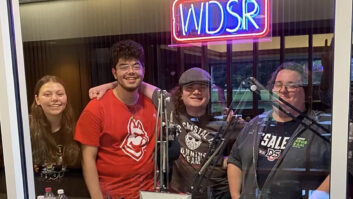Team Radio
Dec 1, 2010 1:00 AM, By Ray Klotz, CPBE DRB AMD CBNT

A view of the Poncan Theater from across the street. The radio station is to the right of the box office.
KPNC has been a family business for several decades in Ponca City, OK. Add KLOR in Ponca City and KOKB licensed to Blackwell and you have the flagship trio of Team Radio. Team Radio also owns KOSB in Stillwater, OK, and KOKP in Perry, OK. These two are programmed from studios in Stillwater.
Downtown Ponca City was once the studio home of KLOR, but years ago the studios were relocated to the site of the KPNC studios southeast of town. Those facilities grew old and needed an upgrade. Station owner Bill Coleman wanted to remodel the former studio site downtown. However, a storm in July 2009 left the brick front of the building lying in the street. That was that. Coleman still wanted to be downtown and found space available in the Poncan Theater.

A close up of the radio station
No reproductions
Built in 1927, the Poncan Theater is a fully functioning stage theater. The theater itself has been renovated in recent years and has most of the original woodwork, decor and accessories. It is home to the largest collection of original classic movie posters in the country. Amid original period items, the stage equipment, lighting and sound are state-of-the-art.
The radio station occupies part of the ground floor and the street side of the balcony level. Two on-air control rooms are on the ground floor and are fully visible from the sidewalk. Upstairs is the TOC, production room, programming, sales and management offices.
With all the antiques in the theater, which is on the National Register of Historic Places, the building owners wanted us to either keep original antiques in our decor or be modern in contrast. For example, if an antique lamp is used, it must be from the 1920s, not a reproduction of a period piece. We went modern — very modern. This is a state-of-the-art facility.

The KLOR control room provides for three to four guests. Wall-mounted computer monitors provide Blinky-Flashies as a high-tech way of showing off for viewers.
Construction in the building posed some difficulties. Several structural steel columns were where we wanted to put walls. The downstairs area was completely rebuilt within the space allotted. The two on-air control rooms were built as isolated boxes touching only the floor. Walls that look like they are in contact with the building walls are not actually touching. A small gap separates them. Upstairs the production room had very little done construction wise. Carpet, ceiling tiles and acoustical wall treatment provided acceptable results. The TOC has a separate air conditioning system for the equipment.
The facility design and system integration was handled by Sierra Multimedia in Bella Vista, AR. After the design phase, local contractors were used for the construction. All of the station equipment was shipped directly to the Sierra facility in Arkansas. It was there that the racks and studio cabinetry were assembled, equipment mounted, wired and tested. This was a complete fully functioning radio station. Once complete, it was shipped to the Poncan Theater for final installation. All wiring plans were completed before any cables were connected. Every cable is numbered and the station is fully documented. Sierra Multimedia engineers and technicians also designed and installed the IT systems.
–continued on page 2
Team Radio
Dec 1, 2010 1:00 AM, By Ray Klotz, CPBE DRB AMD CBNT

KPNC is a mirror image of KLOR.
Details
The operation centers around Logitek IP-based Jetstream-Mini audio engines and Remora 10-fader consoles. The Jetstream chassis is 2RU and is convection-cooled, thus quiet in the room. Logitek’s intention was for them to be mounted in each studio and then networked. However, in this installation there are very few audio components actually in the studios so it was more cost effective to have three Jetstreams rack mounted in the TOC and all audio home-run to there. Only the microphones and their processors, CD player, monitor amps and speakers and headphone amps are actually in the studio. All of the computers, monitor receivers, the Comrex STAC phone systems, EAS and other critical equipment are all in the TOC.
Each Jetstream audio engine has slots for eight input or output cards, either analog or digital. A gigabit network connects the Jetstreams together so that any input can be used in any studio or routed to any output in the system.
The entire studio installation is wired using Studio Hub+. This uses shielded CAT5 cables with RJ-45 connectors. RJ-45 patch panels from Studio Hub are used between the TOC and each studio. Since the Jetstream inputs and outputs are Studio Hub compliant, the wiring went quickly.

The production room on the second floor is adjacent to the TOC.
Three Broadcast Tools switchers are used for the transmitter feeds, one for each station. Included on these switchers are all three studios and automation systems. This allows total flexibility in using studios for production or doing maintenance as needed. These switchers interface with the Logitek system and operators have control buttons in each studio.
The TOC is also a small room so everything had to fit into three racks. The front side of the first rack is for transmitter-feed switching and engineering functions. A 22″ monitor is rack-mounted along with a pull-out keyboard drawer and rack-mounted KVM switches. Other devices and 22 PCs can be monitored and administrated.

Graham Studio’s cabinetry, racks and the electronics were shipped to Sierra Multimedia in Arkansas for assembly, wiring and testing.
With the engineering KVMs and many of the computers available in several studios for redundancy and convenience, almost all of the computer’s keyboard, mice and monitors are split. The use of wide-screen format monitors throughout the station brought out one problem. Computer monitors report to the computer their make, model and resolution through a protocol called EDID. Computers then set the video card settings accordingly. On many systems, if the computer thinks the monitor is a 4:3 aspect ratio monitor, it will not even offer wide-screen formats to choose. With VGA splitters and KVM switches that do not pass the EDID to the computer, 4:3 formats cannot be chosen. The reason this is a problem is that the monitor will stretch the image — circles become ovals.
The solution to this was to trick the computer into thinking a monitor of the desired format and resolution was connected directly to the computer. This was accomplished using a device from Gefen called a DVI Detective. Once set it always reports to the computer that the monitor is what you want it to be.
— continued on page 3
Team Radio
Dec 1, 2010 1:00 AM, By Ray Klotz, CPBE DRB AMD CBNT

The TOC holds all the audio, computers, switchers and IT for the studios and offices.
From here to there
The KOKB transmitter is 15 miles northwest of the studio. The KLOR and KPNC transmitters are collocated north of Ponca City. Due to the buildings around the Poncan Theater downtown, a normal 950MHz STL path is marginal at best. Also, KOKB normally carries programming originating at the Stillwater studios. We had to get creative.
Tieline Bridge-IT pairs are used for an intercity relay from Stillwater. This feeds the studio-quality audio over the Internet with very low delay. KOKB’s main studio site is the Poncan Theater so that programming must pass through the new studios. Since a good path is not available, another pair of Tieline Bridge-IT units are used as the STL.
Because there is not a good STL path from downtown to the KLOR/KPNC transmitter site north of town, another approach had to be found. While we could use an IP system over an Internet connection, we had a better idea.

Behind the TOC racks is the area where the office telephone system is located along with the connections to the studio phone system, the Enberg alert system, and GPIO for the consoles, automation and switchers. At the top are the fiber connections and media converters.
Have you had your fiber today?
Ponca City is a very technologically advanced community. The city has provided city-wide free Wi-fi. It has also wired most of the downtown area as well as other locations with fiber optics. Since the city has some of its radio equipment on the KLOR tower, fiber also goes to the transmitter site. A deal was made to use two strands of fiber between the Poncan Theater and the transmitter.
It is most common to use two fiber strands to make a computer network connection — one in each direction. However, in this case Planet WDM media converters were used to provide two separate and independent bidirectional 1GB network connections. One is used as an extension of the main network providing Internet and remote control access for the site. Installation of the media converters and all of the station’s fiber was also completed by Sierra Multimedia technicians.
An additional Jetstream audio engine was placed at the transmitter site connected to the others over one of the fiber-based network connections. This serves as the STL. Because of the topology of the networked engines, the audio literally comes right out of the console into the processing — at the transmitter site! Connections to the transmitter equipment itself were done by the station’s regular engineer, Tim Diehl of RF Solutions in Tulsa.

Cables going from the ladder rack down through the floor to the two studios downstairs.
Due to the buildings downtown, satellite dishes could not be installed at the studio. Three dishes are in use at the transmitter site. Audio is connected to the Jetstream there and is available in all of the studios downtown.
Station owner Bill Coleman wanted a showcase. Large windows at one end of the on-air control rooms make the studios easily viewable from the sidewalk. Show business was at the forefront of the design. On the walls opposite the large windows are three large computer monitors. Their purpose is part function, but mostly show. One monitor is a graphical representation of the station audio displaying real-time VU meters as well as fader position and on/off status. Another monitor displays custom AutoPilot screens of the transmitter remote control operation. This screen can also be brought up on a desktop monitor adding keyboard and mouse control for transmitter operation. The third is the display from a Microgen modulation analyzer. This displays many off-air parameters with graphical modulation monitors, stereo image display and a spectrum baseband of the stereo composite. These monitors make up what has become known as Blinky-Flashies. They yield a very high-tech look to the studios.
Equipment list
APC UPS
Broadcast Tools ACS 8.2+RJ, SM-III
Burk ARC-Plus, AutoPilot Plus
Cisco RV082/042
Comrex Stac
Denon DN-C640
DM Engineering Multiple Station EAS Adapter
Enberg Alert Monitor, Studio Warning Light
Gefen DVI Detective
Graham Studios cabinetry
Heil Sound PR40
Logitek Jetstream, Remora 10
Microgen TS9080
Middle Atlantic racks, panels and hardware
Netgear GSM7224
Network Technologies KVM cables and splitters
Pilot WDM fiber/copper gigabit media converters
Radio Systems Studio Hub+
Sage Digital Endec
Sony XDRF1HD
Startech VGA splitters and KVM switches
Tieline Bridge-IT
WRN program automation computers
Klotz is president of Sierra Multimedia, Bella Vista, AR.












